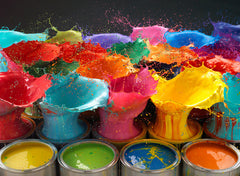A History Of Paint

What would the world be like without paint? A non-uniform mess of natural colours and tones? A duller, less unique place? For one, fine art as we know would no longer exist. Say goodbye to your Monets, the scattered splashes that make up a Jackson Pollock and a firm bye bye to Basquiat. Imagine the bare walls of homes across the world, the industrial look of cars and machines, rusting girders turning a deep red hue. So what is paint and why is it so important to our daily lives? In today’s blog we turn the Creative Awards London spotlight onto paint and explore the history of the perfectly pigmented liquid.
What is paint you may ask?
/pe?nt/
noun
A coloured substance which is spread over a surface and dries to leave a thin decorative or protective coating.
 The first paints appeared around 30,000 years ago with our ancient ancestors using crude incarnations made from red or yellow ochre, haematite, manganese oxide, and charcoal to leave behind representations of their daily lives on the walls of the caves they once inhabited. Indeed, paint and painting became a method not just to express their daily lives but the abstract; dreams, hopes and fears all neatly communicated through one of mankind’s oldest inventions.
The first paints appeared around 30,000 years ago with our ancient ancestors using crude incarnations made from red or yellow ochre, haematite, manganese oxide, and charcoal to leave behind representations of their daily lives on the walls of the caves they once inhabited. Indeed, paint and painting became a method not just to express their daily lives but the abstract; dreams, hopes and fears all neatly communicated through one of mankind’s oldest inventions.
 Paint, both for use within the arts and for industrial purposes, evolved as new methods, techniques and pigmentations came and went. Regardless, our love of colour and expression grew at an astonishing rate. It wasn’t until the industrial revolution that the paint and coatings industry became recognised as a key component within economies across the globe. In 1718, Marshall Smith invented a "Machine or Engine for the Grinding of Colours" in England. It is not known precisely how it operated, but it was a device that increased the efficiency of pigment grinding dramatically. Soon, a company called Emerton and Manby was advertising exceptionally low-priced paints that had been ground with labour-saving technology.
Paint, both for use within the arts and for industrial purposes, evolved as new methods, techniques and pigmentations came and went. Regardless, our love of colour and expression grew at an astonishing rate. It wasn’t until the industrial revolution that the paint and coatings industry became recognised as a key component within economies across the globe. In 1718, Marshall Smith invented a "Machine or Engine for the Grinding of Colours" in England. It is not known precisely how it operated, but it was a device that increased the efficiency of pigment grinding dramatically. Soon, a company called Emerton and Manby was advertising exceptionally low-priced paints that had been ground with labour-saving technology.
By the onset of the Industrial Revolution paint was being ground in steam-powered mills, and an alternative to lead-based pigments had been found in a white derivative of zinc oxide. Interior house painting increasingly became more common as the 19th-century progressed, both for decorative reasons and because paint was effective in preventing damage from environmental factors.
 The late 19th century witnessed a boom in paint factories and, as mechanisation was making the manufacturing process more accessible, paint become both cheaper, more widely used and more available. What's more, the Industrial Revolution not only led the creation of the commercial paint industry but also required its use in the form of protective coatings that both protected and extended the life of the manufactured goods. Indeed, such is the use of paint that the industry is forecast to be worth around £232 billion in 2027.
The late 19th century witnessed a boom in paint factories and, as mechanisation was making the manufacturing process more accessible, paint become both cheaper, more widely used and more available. What's more, the Industrial Revolution not only led the creation of the commercial paint industry but also required its use in the form of protective coatings that both protected and extended the life of the manufactured goods. Indeed, such is the use of paint that the industry is forecast to be worth around £232 billion in 2027.
Colour matching, advances in colour blending and pigmentation have given rise to a palette of colours that is breathtaking. Paint, indeed has certainly became more than the sum of its parts and is revered across fashion, design and architecture. Who can think of paint without the great Pantone being uttered in the same breath? Its influence through the Colour of the Year on the creative industries has become legendary.
 From humble beginnings in the caves of Africa to being used within nearly every manufacturing process paint, a liquid form of colour and protection, is certainly here to stay. A world without paint would be lifeless and dull, a wasteland of oxidation, rust clawing at the structures that hold up our modern society, cars stripped of all personality and walls, lonely and sparse, canvases lifeless and dull. So, here is to you, paint as we raise our brushes and thank you for all that you do for us.
From humble beginnings in the caves of Africa to being used within nearly every manufacturing process paint, a liquid form of colour and protection, is certainly here to stay. A world without paint would be lifeless and dull, a wasteland of oxidation, rust clawing at the structures that hold up our modern society, cars stripped of all personality and walls, lonely and sparse, canvases lifeless and dull. So, here is to you, paint as we raise our brushes and thank you for all that you do for us.



